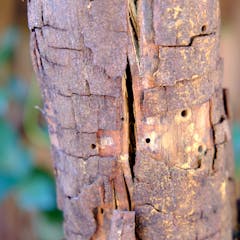
Articles on Invasive species
Displaying 1 - 20 of 321 articles

The emerald ash borer is a destructive invasive pest which has killed tens of millions of trees across North America and has now been sighted in Vancouver.

More than 700 million hectares of land in Africa has been degraded by human activity. Everyone can get involved in restoring the ecology.

Not all reparations involve money. Returning unique scientific resources is also a way of showing respect and righting past harms.

NoMowMay is a catchy concept, but it doesn’t provide the food that native North American pollinators need or lasting support for them.

If the needs of both parasites and hosts are met by the niche, they can move in. Increasing biodiversity may therefore be a double-edged sword.

Such massive disruptions have in the past been caused by volcanoes or meteorites. Only humans have done this with full awareness of their actions.

The sad case of the Norfolk Island morepork shows we need a way to control or eradicate invasive rodents without killing native species.

Wild bees face risks from domesticated bees, habitat loss, and climate change. Supporting bee diversity in Ontario is an important component of promoting a healthy environment.

Two-thirds of conservation actions studied were found to benefit target ecosystems and species.

Water lettuce forms dense mats on the water surface. This can reduce light penetration and oxygen levels in the water, negatively affecting all aspects of aquatic life.

New research suggests if we can’t eradicate cane toads, we can teach wildlife not to eat them.

Bushwalkers with smartphones could help scientists track a fungus lethal to many of Australia’s most loved trees.

Tardigrades are tiny animals known for their extraordinary survival skills, but are they tough enough to survive a space-probe crash and conditions on the Moon?

We need every tool at our disposal to stop feral cats and foxes from decimating Australia’s incredible wildlife after fires. Artificial refuges show promise.

It’s a horror story unfolding in the west that could sweep across the country. Beware the shot-hole borer, an exotic pest that threatens our tree crops, plantations, urban forests and wild places.

Cane toads are evolving as they spread across Australia. Parasitic lungworms are becoming more infectious to keep up.

It’s hard work saving birds from extinction, but we have the evidence of successful interventions to show we can avoid further losses.

It wasn’t just colonists and convicts who invaded Australia in 1788 – invasive plant species arrived too.

There are hundreds of lost tetrapod species across the globe and their number are increasing decade-on-decade. This study aims to find out why some are rediscovered, while others are not.

Conservation dogs perform vital roles across Australia. Some are guardians protecting wildlife from predators while others put their powerful sense of smell to use as sniffer dogs or detection dogs.





